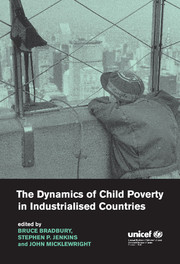Book contents
- Frontmatter
- Contents
- List of figures
- List of tables
- Notes on the contributors
- Acknowledgements
- 1 Beyond the snapshot: a dynamic view of child poverty
- Part I Issues and cross-national evidence
- Part II Topics in child poverty dynamics
- 5 Income mobility and exits from poverty of American children
- 6 Child poverty in Germany: trends and persistence
- 7 Poverty among British children: chronic or transitory?
- 8 Child income poverty and deprivation dynamics in Ireland
- 9 Young people leaving home: the impact on poverty in Spain
- 10 Are children being left behind in the transition in Hungary?
- 11 Mobility and poverty dynamics among Russian children
- Summary and policy conclusions
- Index of authors
- Index by subject
9 - Young people leaving home: the impact on poverty in Spain
Published online by Cambridge University Press: 02 December 2009
- Frontmatter
- Contents
- List of figures
- List of tables
- Notes on the contributors
- Acknowledgements
- 1 Beyond the snapshot: a dynamic view of child poverty
- Part I Issues and cross-national evidence
- Part II Topics in child poverty dynamics
- 5 Income mobility and exits from poverty of American children
- 6 Child poverty in Germany: trends and persistence
- 7 Poverty among British children: chronic or transitory?
- 8 Child income poverty and deprivation dynamics in Ireland
- 9 Young people leaving home: the impact on poverty in Spain
- 10 Are children being left behind in the transition in Hungary?
- 11 Mobility and poverty dynamics among Russian children
- Summary and policy conclusions
- Index of authors
- Index by subject
Summary
Why focus on young people?
One of the features of Spanish society that puzzles foreign observers is how Spain can have an unemployment rate and an incidence of temporary jobs that are well above those of other European Union countries (especially for young people) while, at the same time, keeping a fairly high degree of social cohesion. And all this without spending more on social protection than neighbouring countries. The answer to the puzzle may be found in the predominant role played by the family in Spanish society (see, for example, Robinson 1998). Family ties are critical in Spain in ensuring financial protection against adverse labour-market conditions. Indeed, despite its high unemployment rate, Spain has an incidence of jobless households – households in which no one is employed – which is no higher than the average for the European Union. Against this background, this chapter explores the relationship between poverty, living arrangements and the labour market, focusing on young people.
The sharp rise in unemployment in Spain since the early 1980s and the increasing flexibility in the labour market have especially affected young people – those persons who have just left childhood – who are the focus of this chapter. In parallel with the increases in unemployment and temporary employment among the young, there has been a growing proportion of young people, particularly of those aged 25–29, still living with their parents.
- Type
- Chapter
- Information
- The Dynamics of Child Poverty in Industrialised Countries , pp. 215 - 235Publisher: Cambridge University PressPrint publication year: 2001
- 4
- Cited by

